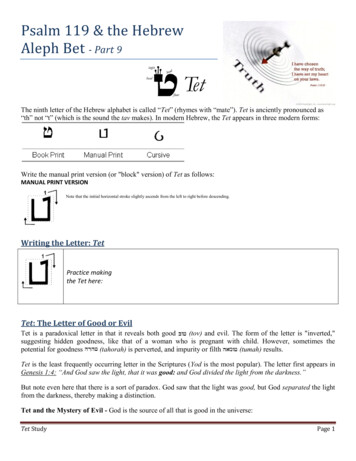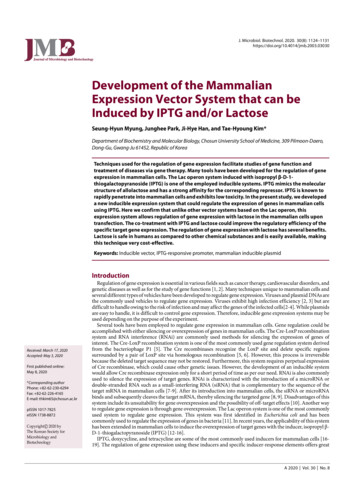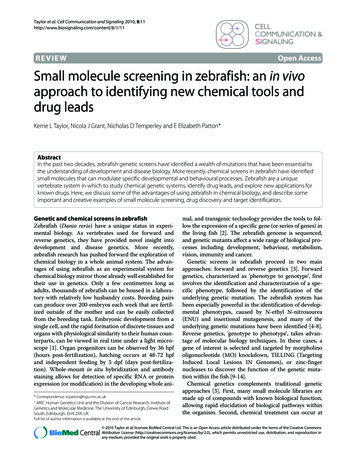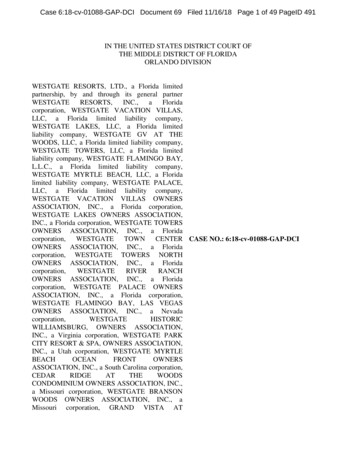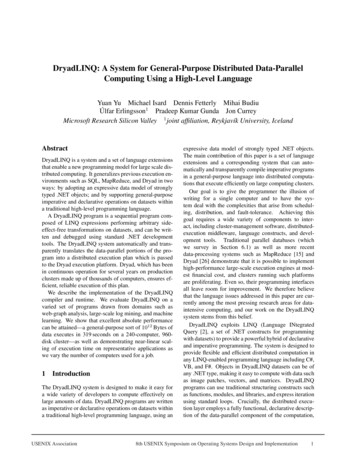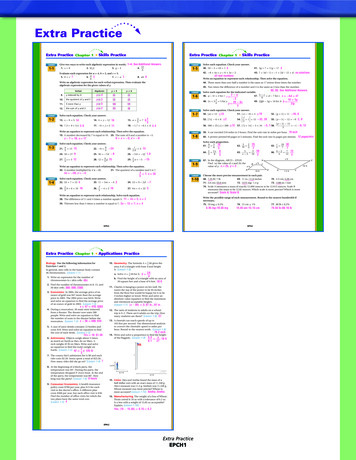
Transcription
Clontech Laboratories, Inc.Tet-One InducibleExpression SystemUser ManualCat. No. 634301(032315)Clontech Laboratories, Inc.A Takara Bio Company1290 Terra Bella Avenue, Mountain View, CA 94043, USAU.S. Technical Support: tech@clontech.comUnited States/Canada800.662.2566Asia Pacific 1.650.919.7300Europe 33.(0)1.3904.6880Japan 81.(0)77.543.6116
Tet-One Inducible Expression System User ManualTable of ContentsI.Introduction. 3II.List of Components. 4III. Additional Materials Required. 4IV. Protocol Overview . 6V.Cloning Your Gene of Interest into a pTetOne Vector using In-Fusion HD . 7VI. Pilot Testing Tet-Based Induction of Your Construct . 8A. Materials Required . 8B. Protocol . 8VII. Creating & Screening for a Tet-One Stable Cell Line Capable of High Induction of your GOI . 9A. Materials Required . 9B. Protocol: Creating a Stable Tet-One Inducible Cell Line . 9C. Protocol: Screening Your Tet-One Inducible Clones. 10VIII. References. 11IX. Troubleshooting . 12Appendix A: Tet-One Vector Information . 14Appendix B: Why Use a Linear Selection Marker?. 15Appendix C: Selecting Stable Clones via Limited Dilution of Suspension Cells . 16Appendix D: Preparing and Handling Cell Line Stocks . 17Table of FiguresFigure 1. The Tet-On 3G and Tet-One Systems allow inducible gene expression in the presence of Dox. . 3Figure 2. Establishing an inducible expression system in target cells with Tet-One. . 6Figure 3. The In-Fusion HD Single-Tube Cloning Protocol. 7Figure 4. Transfection of the pTetOne plasmids into target cells in a 6-well plate. . 8Figure 5. pTetOne Vector Map. . 14Figure 6. pTetOne-Luc Control Vector Map . 14Table of TablesTable 1. Recommended Antibiotic Concentrations for Selecting & Maintaining Stable Cell Lines . 4Table 2.Troubleshooting Guide for the Tet-One Inducible Expression System . 12(032315)www.clontech.comClontech Laboratories, Inc. A Takara Bio CompanyPage 2 of 18
Tet-One Inducible Expression System User ManualI.IntroductionA.SummaryThe Tet-One Systems are inducible gene expression systems for mammalian cells that contain all thenecessary components in a single plasmid, lentiviral, or retroviral vector. After transfecting target cellswith plasmid (Tet-One System), or transducing them with lentivirus (Lenti-X Tet-One Systems) orretrovirus (Retro-X Tet-One systems), the cells will express the Tet-On 3G transactivator protein andcontain a gene of interest (GOI) under the tight control of a TRE3G promoter (PTRE3GS). This manualdescribes the plasmid-based Tet-One Inducible Expression System (Cat. No. 634301). Using thissystem, your target cells will express high levels of your GOI, but only when cultured in the presence ofdoxycycline (Dox) (Figure 1).Figure 1. The Tet-On 3G and Tet-One Systems allow inducible gene expression in the presence of Dox.B.Elements of Tet-One SystemsTet-On 3G Transactivator ProteinBased on the transcriptional regulators described by Gossen & Bujard (1992), Gossen et al. (1995), andUrlinger et al. (2000), Tet-On 3G is a modified form of the Tet-On Advanced transactivator protein whichhas been evolved to display far higher sensitivity to doxycycline (Zhou et. al,. 2006).PTRE3GS Inducible PromoterThe inducible promoter PTRE3G provides for very low basal expression and high maximal expression afterinduction (Loew et. al., 2010). It consists of 7 repeats of a 19 bp tet operator sequence located upstreamof a minimal CMV promoter. PTRE3GS is a version of PTRE3G that was modified for higher performance in asingle vector context. In the presence of Dox, Tet-On 3G binds specifically to PTRE3GS and activatestranscription of the downstream GOI. PTRE3GS lacks binding sites for endogenous mammaliantranscription factors, so it is virtually silent in the absence of induction.Tet-One Systems “All-in-One” DesignBefore the Tet-One Systems were developed, Clontech’s Tet-On and Tet-Off products all required twoseparate vectors to introduce the transactivator protein and the inducible promoter controlling your geneof interest, respectively, into your target cells. The Tet-One Systems provide both of these components ona single vector. The Tet-On 3G transactivator is expressed in the forward direction from the humanphosphoglycerate kinase 1 promoter, and the cloned gene of interest is expressed from the PTRE3GSpromoter in the reverse orientation. Compared to the two-vector Tet-On 3G Systems, all previouslypublished all-in-one vectors have shown a low signal-to-noise ratio, typically providing only 50–100-foldinduced expression, even in selected clones. Clontech’s Tet-One Systems are based on an all-in-onedesign that has shown up to 25,000-fold induction (Heinz et. al,. 2011).(032315)www.clontech.comClontech Laboratories, Inc. A Takara Bio CompanyPage 3 of 18
Tet-One Inducible Expression System User ManualC.DoxycyclineDoxycycline is a synthetic tetracycline derivative that is the effector molecule for all Tet-On and Tet-OffSystems. When bound by Dox, the Tet-On 3G protein undergoes a conformational change that allows it tobind to tet operator sequences located in the PTRE3GS promoter (Figure 1). The Dox concentrations requiredfor induction are far below cytotoxic levels for either cell culture or transgenic studies, and Tet-On 3Gresponds to even lower concentrations than its predecessors (Zhou et. al,. 2006). Note that Tet-On Systems(including Tet-One) respond well only to doxycycline, and not to tetracycline (Gossen & Bujard, 1995).The half-life of Dox in cell culture medium is 24 hours. To maintain continuous inducible GOI expressionin cell culture, the medium should be replenished with Dox every 48 hours.II.List of ComponentsStore all components at -20 C.Tet-One Inducible Expression System (Cat. No. 634301) III.1 eachpTetOne Vector Set (Cat. No. 634303; not sold separately) 100 rxns 20 μlpTetOne Vector (500 ng/µl) 20 μlpTetOne-Luc Control Vector (500 ng /µl) 40 μlLinear Hygromycin Marker (50 ng/µl) (also sold separately as Cat. No. 631625) 40 μlLinear Puromycin Marker (50 ng/µl) (also sold separately as Cat. No. 631626)Xfect Transfection Reagent (Cat. No. 631317) 2 tubes Xfect Polymer (75 μl each) 2 tubes Xfect Reaction Buffer (12 ml each)Tet System Approved FBS, US-Sourced (Cat. No. 631105)50 mlAdditional Materials RequiredThe following reagents are required but not supplied.A.Tetracycline-Free Fetal Bovine SerumContaminating tetracyclines, often found in serum, will significantly elevate basal expression when usingTet-On 3G. The following functionally tested tetracycline-free sera are available from Clontech:Cat. No.631106631107631101631105B.Serum NameTet System Approved FBS (500 ml)Tet System Approved FBS (50 ml)Tet System Approved FBS, US-Sourced (500 ml)Tet System Approved FBS, US-Sourced (50 ml)Antibiotics for Selecting Stable Cell LinesTable 1. Recommended Antibiotic Concentrations for Selecting & Maintaining Stable Cell LinesRecommended Concentration (µg/ml)Selecting Colonies1Cat. No.Antibiotic631306Puromycin (100 mg)631305Puromycin (25 mg)631309Hygromycin B (1 g)Maintenance0.25–100.2550–4001001When selecting for single colonies, the appropriate dose must be determined empirically for your specific cell line.Test a dosage range using dishes of untransfected cells and choose the dose that kills all of the cells in 3–5 days. Ifall the cells die in less than 24 hr, you should use a lower dose.(032315)www.clontech.comClontech Laboratories, Inc. A Takara Bio CompanyPage 4 of 18
Tet-One Inducible Expression System User ManualC.D.Mammalian Cell Culture Supplies Culture medium, supplies, and additives specific for your target cells Trypsin/EDTA (e.g., Sigma, Cat. No. T4049) Cloning cylinders or discs for isolating colonies of adherent cell lines (Sigma, Cat. No. C1059) Cell Freezing Medium, with or without DMSO (Sigma, Cat. Nos. C6164 or C6039), for freezingstable Tet-One cell lines. 6-well, 12-well & 24-well cell culture plates, 10 cm cell culture dishesDoxycycline 5 g Doxycycline (Cat. No. 631311)Dilute to 1 mg/ml in double distilled H2O. Filter sterilize, aliquot, and store at –20 C in the dark. Usewithin one year.E.Xfect Transfection ReagentXfect Transfection Reagent provides high transfection efficiency and low cytotoxicity for mostcommonly used cell types.Cat. No.631317631318F.Transfection ReagentXfect Transfection Reagent (100 rxns)Xfect Transfection Reagent (300 rxns)In-Fusion HD Cloning SystemIn-Fusion is a revolutionary technology that greatly simplifies cloning.For more information, visit www.clontech.com/infusionCat. No.638909638910638911G.In-Fusion Cloning KitIn-Fusion HD Cloning Plus (10 rxns)In-Fusion HD Cloning Plus (50 rxns)In-Fusion HD Cloning Plus (100 rxns)Stellar Competent CellsWe recommend using Stellar Competent Cells (see Section V), which are included in the In-Fusion HDCloning Kits listed in Section III.F. You can also purchase these cells separately (Cat. No. 636763).H.TetR Monoclonal AntibodyIf you wish to confirm that Tet-On 3G is expressed in your cells, we recommend that you use thefollowing antibody and detect the protein via Western Blot.Cat. No.631131631132I.J.AntibodyTetR Monoclonal Antibody (Clone 9G9) (40 µg)TetR Monoclonal Antibody (Clone 9G9) (200 µg)Plasmid Purification (Transfection-Grade)Cat. No.ProductSize740412.10NucleoBond Xtra Midi Plus10 preps740416.10NucleoBond Xtra Maxi Plus10 preps740422.10NucleoBond Xtra Midi EF Plus10 preps740426.10NucleoBond Xtra Maxi EF Plus10 prepsLuciferase Assay and LuminometerThese items are required when using the pTetOne-Luc Vector as a control to test for induction (SectionVI.B). Use any standard luciferase assay system and luminometer.(032315)www.clontech.comClontech Laboratories, Inc. A Takara Bio CompanyPage 5 of 18
Tet-One Inducible Expression System User ManualIV.Protocol OverviewPlease read each protocol completely before starting. Successful results depend on understanding and performingthe following steps correctly.A.General Cell CultureThis user manual provides only general guidelines for mammalian cell culture techniques. For usersrequiring more information on mammalian cell culture, transfection, and creating stable cell lines, werecommend the following general reference:Freshney, R.I. (2005). Culture of Animal Cells: A Manual of Basic Technique, 5th Edition (WileyLiss, Hoboken, NJ).B.Protocol SummaryThe following are the steps required to create a doxycycline-responsive cell line capable of inducibleexpression of your gene of interest (GOI) (see Figure 2).1. Clone your gene of interest into the pTetOne Vector using In-Fusion HD (Section V).2. Pilot test Tet-based induction of your construct (Section VI).3. Create and screen for a stable TetOne clone capable of high induction of your GOI (Section VII).Figure 2. Establishing an inducible expression system in target cells with Tet-One. Target cells are cotransfected with the pTetOne plasmidcontaining your gene of interest and one of the linear selection markers (HygR or PuroR). Clones are then selected with antibiotic, expanded, andscreened for doxycycline-inducible expression of your gene of interest.(032315)www.clontech.comClontech Laboratories, Inc. A Takara Bio CompanyPage 6 of 18
Tet-One Inducible Expression System User ManualV.Cloning Your Gene of Interest into a pTetOne Vector using In-Fusion HDWe recommend using In-Fusion HD for all cloning. Follow the protocol outlined in the In-Fusion HD user manual atwww.clontech.com/infusionNOTE: Stellar Competent Cells (Section III.G) are recommended by Clontech for In-Fusion cloning. Stellar CompetentCells are provided with all In-Fusion HD Cloning Systems.Figure 3. The In-Fusion HD Single-Tube Cloning Protocol.The recommended linearization sites and forward/reverse primer designs are as follows:VectorLinearize w/Forward Primer*Reverse Primer**pTetOneEcoRI & BamHICCCTCGTAAAGAATTC 111 222 333 444 555 666 777 888GCAGAGATCTGGATCC sss nnn nnn nnn nnn nnn nnn nnn*111 Start codon of your gene; 222 2nd codon of your gene; etc.**SSS reverse compliment of the stop codon of your gene; NNN reverse compliment of the end of your gene.(032315)www.clontech.comClontech Laboratories, Inc. A Takara Bio CompanyPage 7 of 18
Tet-One Inducible Expression System User ManualVI.Pilot Testing Tet-Based Induction of Your ConstructPrior to establishing the stable Tet-One cell line for your GOI, your pTetOne construct should be tested forfunctionality. Transiently transfect your pTetOne vector into an easy-to-transfect cell line such as HeLa or HEK293, or your target cell line, and test for GOI induction with Dox. You will need an appropriate gene-specificassay to test for induction, such as: Western blot Northern blot qRT-PCR Gene-specific functional assaypTetOne-Luc can be used as a positive control.A.Materials Required1. pTetOne Vector containing your gene of interest (Section V)2. Host cell line3. Xfect Transfection Reagent (Section III.E)4. Doxycycline (1 mg/ml) (Section III.D)5. Mammalian cell culture supplies (Section III.C)6. Tet Approved FBS (Section III.A)B.Protocol1. Transfect the pTetOne Vector into your target cells (in a 6-well plate) using Xfect TransfectionReagent. Follow the Xfect Transfection Reagent Protocol-At-A-Glance. (Locate this protocol bysearching at www.clontech.com/manuals). Use 5 µg of pTetOne-GOI for each well (GOI gene of interest). We recommend performing the test in duplicate with negative controls:3 wells containing 100 ng/ml of Dox, and 3 wells without Dox.Wells 1 & 2: 5 µg pTetOne-GOI (no Dox)Wells 3 & 4: 5 µg pTetOne-GOI (100 ng/ml Dox)Well 5: 5 µg pTetOne empty (no Dox)Well 6: 5 µg pTetOne empty (100 ng/ml Dox)Figure 4. Transfection of the pTetOne plasmids into target cells in a 6-well plate.2. After 24 hr, harvest the cell pellets from each well and compare induced expression levels touninduced expression levels using a method appropriate for your GOI.NOTE: Because transiently transfected cells contain more copies of the pTetOne plasmid than dostable cell lines, fold induction (ratio of maximal to basal GOI expression) levels are almost alwayslower in transient assays (e.g., by 10–100 fold) than in properly selected stable clonal cell lines.(032315)www.clontech.comClontech Laboratories, Inc. A Takara Bio CompanyPage 8 of 18
Tet-One Inducible Expression System User ManualVII.Creating & Screening for a Tet-One Stable Cell Line Capable of HighInduction of your GOIA.Materials Required1. pTetOne-GOI Vector (Section V)2. Linear Hygromycin/Puromycin Marker (Section II)3. Target Cell Line4. Xfect Transfection Reagent (Section III.E)5. Hygromycin or Puromycin (Section III.B)6. Doxycycline (1 mg/ml) (Section III.D)7. Mammalian cell culture supplies (Section III.C)8. Tet Approved FBS (Section III.A)B.Protocol: Creating a Stable Tet-One Inducible Cell LineTo generate a highly inducible stable Tet-On 3G inducible cell line, transfect your customized pTetOnevector into your target cell line along with a linear selection marker (Hygr or Purr). Select stabletransfectants by screening for hygromycin or puromycin resistance, and inducibility.NOTE: Working with mixed (polyclonal) populations of transfected cells rather than selecting for singleclones can affect the consistency of induction, due to the possible outgrowth of poorly inducing clones asthe cells are passaged.Why use linear selection markers? See Appendix B.1. Plate (seed) your target cell line in a single well of a 6-well plate at a density sufficient to reach nearconfluence at 48 hr after transfection.2. Using Xfect transfection reagent (PT5003-2 from www.clontech.com/manuals), cotransfect thefollowing: 2 µg pTetOne-GOI 100 ng Linear Selection Marker (puromycin or hygromycin)NOTE: Always combine your customized pTetOne vector and either the Linear Hygromycin Markeror the Linear Puromycin Marker at a ratio of 20:1 (i.e., use 20-fold less of the linear marker).3. After 48 hr, split the confluent cells into 4 x 10 cm dishes (do not add the selective antibiotic yet).4. After an additional 48 hr, add hygromycin or puromycin at the selection concentration that is optimalfor your cell line (Section III.B).5. Replace medium with fresh complete medium plus hygromycin (or puromycin) every four days, ormore often if necessary.(032315)www.clontech.comClontech Laboratories, Inc. A Takara Bio CompanyPage 9 of 18
Tet-One Inducible Expression System User Manual6. Cells that have not integrated the plasmid should begin to die after 3–5 days.NOTE: Avoid passaging the cells a second time, since replating cells under selection may result inplates containing too many colonies for effective colony isolation (because individual colonies are notwell-separated).7. After 2 weeks, drug-resistant colonies should begin to appear.8. When the colonies are large enough to transfer, use cloning cylinders or disks to harvest (i.e. “pick”)large, healthy colonies, and transfer each into a separate well of a 24-well plate. Isolate as many clones as feasible, so that 10– 20 clones are available for testing. Suspension cultures must be cloned using a limiting dilution technique (see Appendix C).9. Culture the clones in maintenance concentrations of hygromycin (or puromycin) (Section III.B).When confluent, split the cells from each well into three wells of a 6-well plate for testing andmaintenance (Section VII.C).C.Protocol: Screening Your Tet-One Inducible ClonesTest individual stable clones for expression of your GOI in the presence and absence of Dox. Chooseclones that generate the highest maximal and lowest basal expression levels, i.e., the highest foldinduction.1. For each clone to be tested, seed 1/3 of the total amount of cells (see Section VII.B, Step 9) into asingle well of a 6-well plate. The cells in this “stock plate” may be propagated, depending upon theresults of the inducibility assay.2. Divide the remaining 2/3 of the cells between duplicate wells of a second 6-well plate. Add Dox(100 ng/ml) to one of the wells and incubate the cells for 48 hr.3. Harvest the cells and use an assay specific for your GOI to compare induced to uninduced expressionof your GOI.4. Select clones with the highest fold induction for propagation and further testing.5. Expand and freeze stocks of each promising clone as soon as possible (Appendix D).NOTE: Once you have chosen the best clone(s), you may choose to determine the minimalconcentration of Dox that is required for high inducible expression and use that minimalconcentration for all subsequent experiments. Remove the cells from one nearly confluent well(of a 6-well plate) and divide them among six wells of a 24-well plate. Titrate doxycyclineconcentrations across these 6 wells (e.g., 0, 1, 10, 50, 100, and 1,000 ng/ml), and assay for inducedexpression after 24 hr. Typically, there is no need to use more than 100 ng/ml Dox, since maximalexpression is often obtained with just 10 ng/ml Dox.(032315)www.clontech.comClontech Laboratories, Inc. A Takara Bio CompanyPage 10 of 18
Tet-One Inducible Expression System User ManualVIII. ReferencesClontech’s Tet Systems were developed in cooperation with Dr. Bujard and his colleagues at the Center for MolecularBiology in Heidelberg (ZMBH) and in Dr. Wolfgang Hillen’s laboratory at the University of Erlangen, Germany.Additional background information on Tet-regulated gene expression systems and an extensive bibliography are availableat the website maintained by TET Systems: http://www.tetsystems.com (Please note that Clontech is not responsible forthe information contained on this website.)Freshney, R.I. (2005). Culture of Animal Cells: A Manual of Basic Technique, 5th Edition (Wiley-Liss, Hoboken, NJ).Sambrook, J., Fritsch, E. F. & Maniatis, T., eds. (2001) Molecular Cloning: A Laboratory Manual, Cold Spring HarborLaboratory Press (Cold Spring Harbor, NY).Gossen, M. & Bujard, H. (1992) Tight control of gene expression in mammalian cells by tetracycline responsivepromoters. Proc. Natl. Acad. Sci. USA 89(12):5547–5551.Gossen, M., Freundlieb, S., Bender, G., Muller, G., Hillen, W. & Bujard, H. (1995) Transcriptional activation bytetracycline in mammalian cells. Science 268(5218):1766–1769.Heinz, N., Schambach, A., Galla, M., Maetzig, T., Baum, C., Loew R., & Schiedlmeier, B. (2011) Retroviral andtransposon-based Tet-regulated all-in-one vectors with reduced background expression and improved dynamic range.Human Gene Ther. 22(2):166–176.Loew, R., Heinz, N., Hampf, M., Bujard, H. & Gossen, M. (2010) Improved Tet-responsive promoters with minimizedbackground expression. BMC Biotechnol. 10:81 (24 November 2010).Sambrook, J., Fritsch, E. F. & Maniatis, T., eds. (2001). Molecular Cloning: A Laboratory Manual, Cold Spring HarborLaboratory Press (Cold Spring Harbor, NY).Urlinger, S., Baron, U., Thellmann, M., Hasan, M.T., Bujard, H. & Hillen, W. (2000) Exploring the sequence space fortetracycline-dependent transcriptional activators: Novel mutations yield expanded range and sensitivity. Proc. Natl. Acad.Sci. USA 97(14):7963–7968.Zhou, X., Vink, M., Klave, B., Berkhout, B. & Das, A. T. (2006) Optimization of the Tet-On system for regulated geneexpression through viral evolution. Gene Ther. h Laboratories, Inc. A Takara Bio CompanyPage 11 of 18
Tet-One Inducible Expression System User ManualIX.TroubleshootingTable 2.Troubleshooting Guide for the Tet-One Inducible Expression SystemDescription of ProblemA. Inducing ExpressionLow fold induction (ratio ofmaximal to basal expressionof the GOI)Possible ExplanationSolutionCellular sequences adjacent to theintegration site of some clones may Screen additional clones (Section VII)affect their expression profiles.Cells were harvested and analyzedHarvest and analyze cells between 18–48 hr.too soon or too late. Optimize transfection protocol.Poor transfection efficiency Optimize density of cell plating; use at60–90% confluency. Optimize passage number of target cells.Poor target cell viability Optimize culture conditions of target cells. The FBS used in the cell culturemedium contains tetracyclinederivatives.Low fold induction of GOIexpression in selected drugresistant stable cell clones.Decrease in fold inductionafter several passagesCellular sequences flanking theintegrated pTetOne expressionconstruct may affect GOIexpression.Mixed cell population in theselected clone (see Section VII.BNote).The appropriate antibiotics aremissing from the cell culturemedium.Optimize tissue culture plasticwareUse Clontech’s Tet System Approved FBS (SectionIII.A), which was functionally tested with Clontech’sstable CHO-AA8-Luc Tet-Off Control Cell Line.Screen additional individual drug-resistant cellclones to ensure optimal fold induction.Maintain optimal antibiotic concentrations (SectionIII.B).orLoss of inducibility afterpassaging of a (previouslyfrozen) stable cell line.(032315)Mixed cell population in theselected clone (see Section VII.BNote).Reselect the current cell line through single colonyselection (Section VII.C).www.clontech.comClontech Laboratories, Inc. A Takara Bio CompanyPage 12 of 18
Tet-One Inducible Expression System User ManualDescription of ProblemPossible ExplanationB. Establishment of Stable Cell LinesUntransduced cells do not dieThe cells have not been recentlyat the high antibioticpassaged, so they remain wellconcentration established viaattached to the plate surface eventitration in Section II.Bwhen they are dead.There are no surviving cellsafter transfection/cotransfection The antibiotic concentration whichwith a drug-resistant expression caused massive cell death whencassette at the antibioticdetermining the appropriate doseconcentration determined to be via titration could be too high.optimal in Section II.BTransfection was inefficientbecause cells used for transfectionwere of unsatisfactory quality,resulting in inefficient uptake ofDNA during transfection.Low number of drug resistantInefficient transfection due to usingclonesthe wrong ratio of Vector/LinearSelection Marker.Antibiotic was added too soon.Used wrong antibiotic concentration. Cells were not split and/ordiluted correctly.Too many colonies for effective Antibiotic was added too late.colony isolation (individual Transfected cells werecolonies are not well-separated) passaged a second time afteraddition of antibiotic.Used wrong antibiotic concentration.Cells were not properly frozen.Poor cell viabilityCells were not properly thawed.C. Detection and Inhibition of ExpressionNo detectable GOI expressionby Western Blot.Continuous protein expressionafter the removal of doxycycline(032315)SolutionTo determine the appropriate antibioticconcentration, use cells that have been splitwithin the last 2–3 days.Use a lower antibiotic concentration for selectionof stably transfected cell clones.Use cells for transfection at passages no higherthan 15–17 since defrosting, and no older than2–3 days since the last split. Passage cells 3–4times after defrosting to allow a complete cellrecovery prior to transfection experiments.Check the ratio of Vector/Linear SelectionMarker. Retransfect Vector/Linear SelectionMarker at a ratio of 20:1 (Section VII.B).See protocol in Sections VII.B.See Section III.B.See protocols in Section VII.B.See Section III.BSee Appendix D, Section A.See Appendix D, Section B.Low sensitivity of detectionmethod.Check sensitivity of primary and secondaryantibodies. Analyze GOI expression by qRTPCR, using different sets of primers to ensureoptimal detection of GOI expression.Depending on the stability of theprotein, it may persist in the cell inthe absence of gene induction andde novo synthesis of GOI mRNA.Fluorescent proteins tend to havelong half-lives.Add a ProteoTuner destabilization domain toyour protein of interest and control its stabilitythrough the addition/removal of Shield1 ligandDoxycyline was not completelyremoved from the cell culturemedium.Wash cells three times with PBS, followed bytrypsinization and replating in fresh mediumsupplemented with Clontech’s Tet SystemApproved FBS. If trypsinization is undesirable,wash cells three times with medium and threetimes with PBS, then replace with fresh mediumsupplemented with Tet System Approved FBS.www.clontech.comClontech Laboratories, Inc. A Takara Bio CompanyPage 13 of 18
Tet-One Inducible Expression System User ManualAppendix A: Tet-One Vector InformationFor complete descriptions of the vectors provided with each system, refer to the enclosed Certificate of Analysis, which isalso available at www.clontech.comFigure 5. pTetOne Vector Map.Figure 6. pTetOne-Luc Control Vector Map(032315)www.clontech.comClontech Laboratories, Inc. A Takara Bio CompanyPage 14 of 18
Tet-One Inducible Expression System User ManualAppendix B: Why Use a Linear Selection Marker?Linear selection markers are short, purified linear DNA fragments that consist of the marker gene (Hygr or Purr), an SV40promoter, and the SV40 polyadenylation signal. Use of a linear selection marker allows you to screen fewer clones toobtain your desired clone; plus, you'll observe a higher fold induction in the clones that you select.Why is this? Because there is less interference with basal expression of the gene of interest from the promoter of acotransfected lin
This user manual provides only general guidelines for mammalian cell culture techniques. For users requiring more information on mammalian cell culture, transfection, and creating stable cell lines, we recommend the following general reference: Freshney, R.I. (2005). Culture of Animal Cells: A Manual of Basic Technique, 5th Edition (Wiley-
